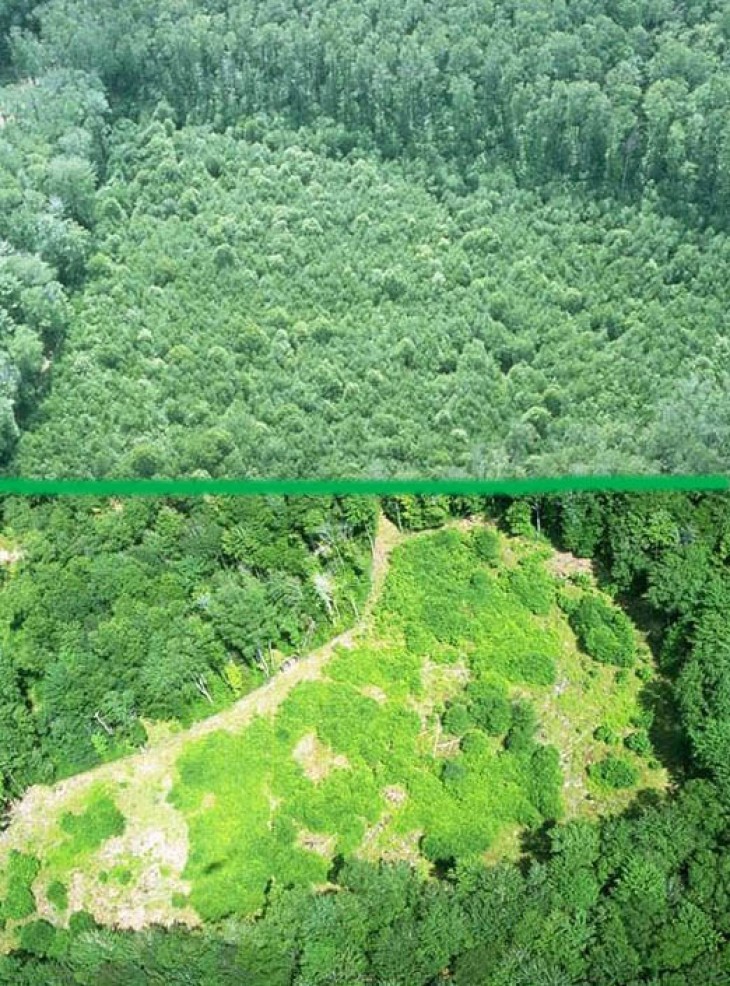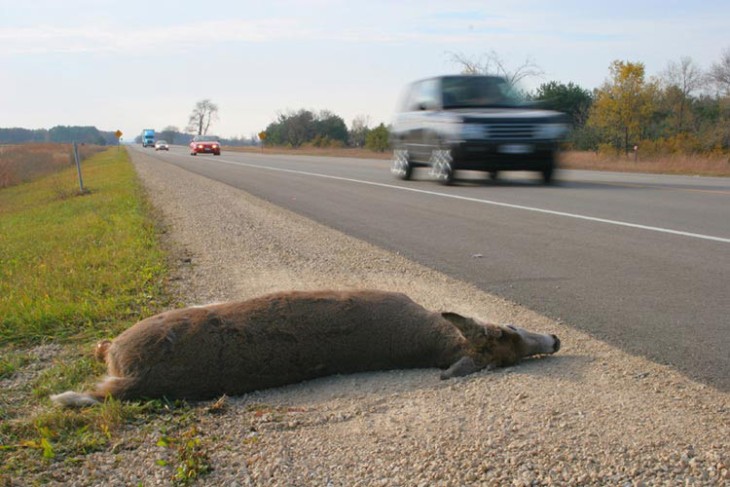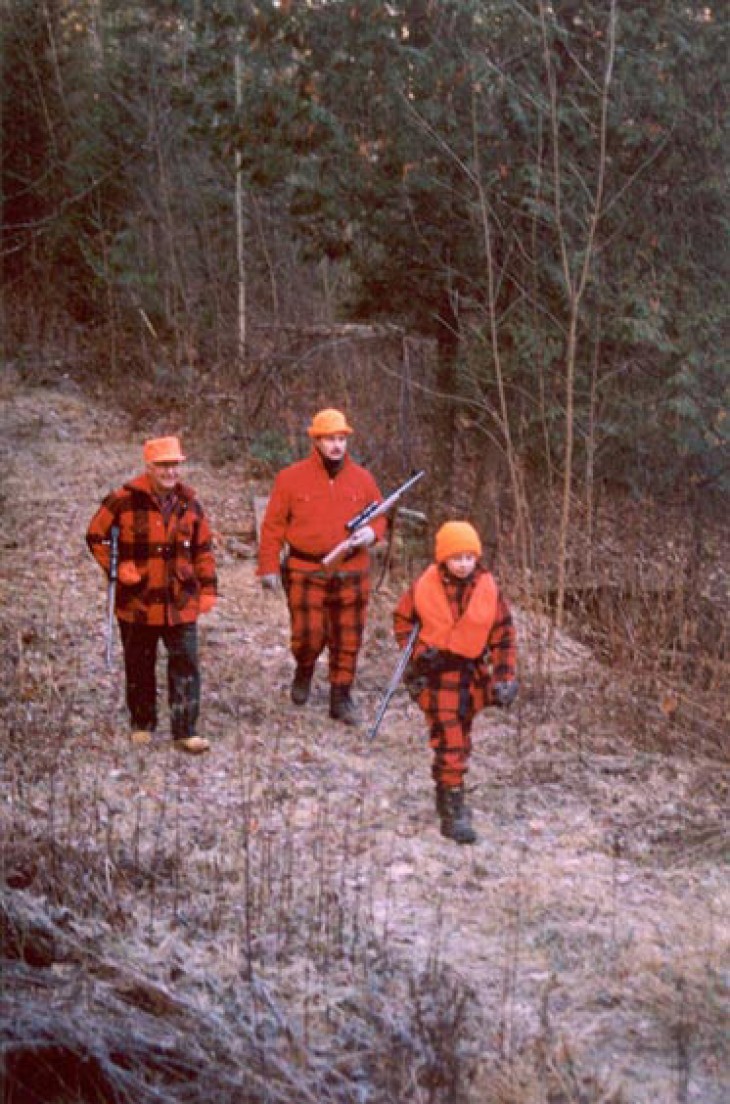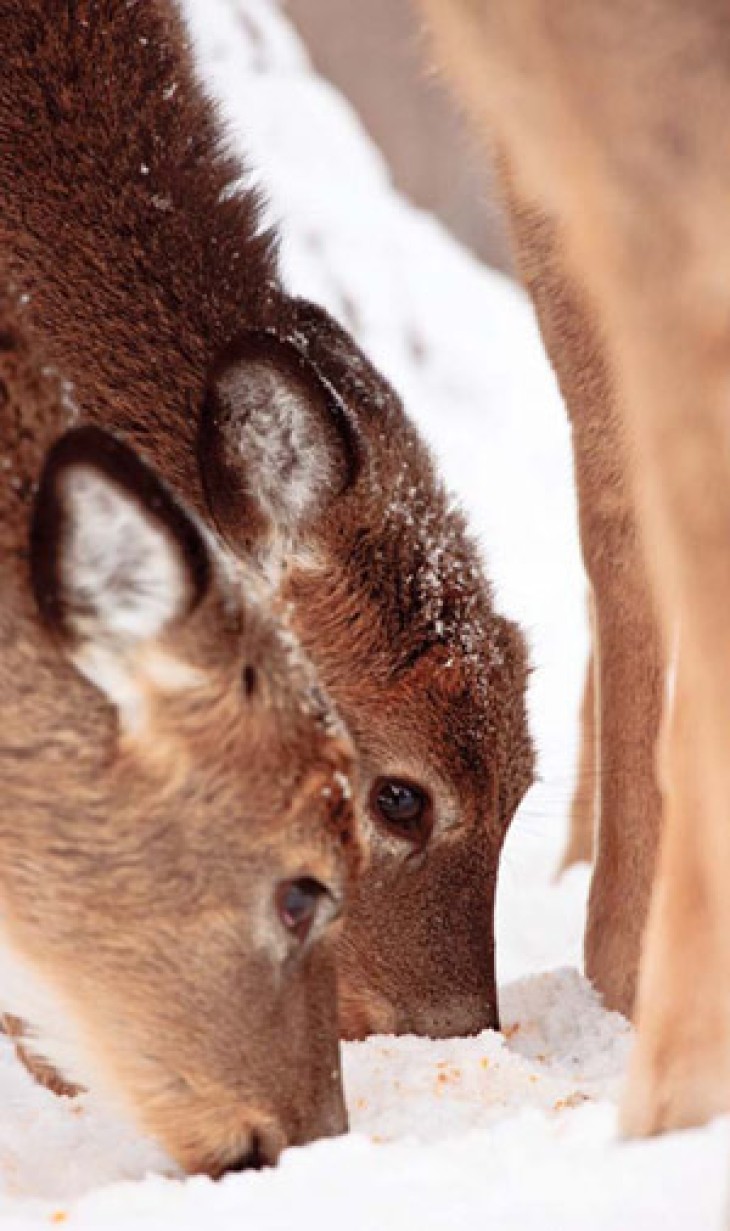Bill Schmidt, of Elysian Hills Tree Farm in southeastern Vermont, says his current deer problem is not as bad as it was twenty years ago. Back then, the deer had a habit of congregating in his 20-acre Christmas tree plantation and nibbling certain balsam fir trees down to broomsticks.
While his Christmas trees have been spared of late, his woodlot still bears testament to the uneasy tension between forest health and deer populations. Things aren’t as bad in southern Vermont as they are in, say, suburban Connecticut, where the forests have been fundamentally altered by deer, the forest floor stripped of wildflowers, and saplings overtaken by species that are unpalatable to deer. But a problem does exist.
Schmidt has seen hardwood seedlings – maple, ash, and oak – with the distinctive frayed edges that show a deer has nipped them to the ground with its lower incisors, then ripped the top off with a pull. He’s seen more beech and birch, an increase in hay-scented fern and non-native species such as buckthorn and barberry, none of which deer like to eat. There are forested areas on his 130-acre farm where new trees just cannot get started.
Schmidt manages his land not just for trees but also for the wildlife that lives there. He likes that his property is home to deer but would prefer that there were fewer of them.
The perception gap
Around northern New England and upstate New York, many landowners, foresters, and wildlife enthusiasts have similarly conflicting feelings about deer. The million-dollar question is: how many deer are too many? Is it when the population density reaches a certain number, like 16 or 20 deer per square mile? Is it when hunters complain that the deer are too skinny and that there are no trophy bucks? Is it when the deer population exceeds the habitat’s carrying capacity? Or when environmental impacts, like loss of wildflowers, become noticeable?
It’s none of these things, says Thomas Rawinski, a botanist with the U.S. Forest Service in Durham, New Hampshire, and an expert on deer overabundance. While all are factors, the criterion that tops all others is the cultural carrying capacity: the number of deer that people are happy having around.
“Every person has a different life experience with deer,” says Rawinski. “They may be orchardists or farmers, or they may have had a vehicle collision or Lyme disease.” All of these influences must be included in the process of deciding how many deer there should be. “Wildlife is owned by everybody, so everybody needs to make the decision.”
An example of these differing reactions can be seen on Bill Schmidt’s tree farm. In southeastern Vermont, deer densities have fallen from a high of 40 deer per square mile in the ’60s and ’70s to half that today, according to Shawn Haskell, the deer project leader for the Vermont Department of Fish and Wildlife. Haskell believes this deer density – roughly 20 deer per square mile – is the right number for a healthy deer population that is in balance with its environment.
Still, a recent public comment period revealed that the region’s foresters would like to see the deer population reduced to a quarter of what it is today. At the same time, hunters in the area are complaining that deer numbers are down; they’re advocating for more deer.
Deer in the headlights
Foresters often have a front-row view of the damage “too many” deer can cause to the landscape. Wildflowers, such as trillium and showy lady’s slippers, can be especially hard hit. “Each adult white-tailed deer eats about 2,000 pounds a year,” says Charlie Fiscella, New York State chapter president of the Quality Deer Management Association “That’s one ton. Go out with clippers and see how long it takes you to clip one ton. It’s hard to do that, especially when the habitat is marginal.”
The Nature Conservancy is just finishing up a study finding that deer are one of the top threats to a healthy forest in New York State, and that oak and maple seedlings are a deer’s favored food source. Since woodlot owners and foresters are also fond of oaks and maples, the deer’s impact is deeply felt. As these commercially valuable hardwood species start disappearing, forest composition can be skewed to favor birch, beech, and hophornbeam.
When deer pressure is overwhelming, you get no seedling regeneration at all. This allows invasive species to fill the void and dominate the ecosystem. As the invasives grow, the deer continue to eat native plants and avoid the invasives, thus giving the invasives a perpetual advantage.
Biologists do caution, however, that deer sometimes get too much blame for bad forest regeneration. In a forest with even-aged trees and an overstory that lets in no light, it may be the tree canopy that’s suppressing the seedling growth. One study found only subtle differences in a deer-free, full-canopy forest plot.
Jeff Ward, chief scientist of the forestry and horticulture section of The Connecticut Agricultural Experiment Station, based in Windsor, Connecticut, has first-hand experience with deer-caused imbalances. “In one study area where there was a ‘high’ deer herd, there was a 100-acre patch that was almost pure Japanese barberry,” says Ward.
Cases when deer do eat invasive plants can be just as much a problem as when they don’t since eating seeds can help the invasives spread. “Several years ago, we gathered over 5,000 deer poops in a greenhouse to see what would grow from them,” said Scott Williams, a deer biologist at the Experiment Station. Thirty-two species of plant that germinated were not native to the state of Connecticut, including Carolina horsenettle, little hogweed, and lambsquarters. “Deer are able to transport hundreds of exotic plant seeds each day to new locations,” said Williams. “That’s one aspect of superabundant deer that people don’t consider.”
As forest composition changes, animals suffer, especially songbirds. The National Audubon Society reports that eastern wood pewees, indigo buntings, least flycatchers, yellow-billed cuckoos, and cerulean warblers are negatively affected when deer populations exceed 20 deer per square mile. At 40 deer per square mile, an area starts to lose eastern phoebes and robins. Ground nesters, including ovenbirds, grouse, woodcock, whippoorwills, and wild turkeys, are vastly reduced.
Clearly, deer influence the environment, but they can also negatively affect our own health and safety. Deer play a role in the spread of Lyme disease, as well as the emerging diseases babesiosis (which has malaria-like symptoms) and human granulocytic anaplasmosis (which has symptoms similar to the flu). They also cause more-direct harm in accidents with vehicles. According to the National Highway Traffic Safety Administration, about 150 people are killed in these accidents nationwide each year, while thousands more are injured. Property damage from such collisions totals $1 billion.

What we hold deer
With so many problems caused by deer overabundance, it’s tempting to see the problem as an act of nature, like a lightning strike or a blizzard. But it is humans who are at the root of our deer problems, not nature. The good news is that what we have caused, we have the power to correct.
When mountain lions and wolves were eliminated from the Northeast, human beings became the white-tailed deer’s major predator. Today, coyotes, bobcats, and black bears do prey on white-tailed deer, especially fawns, but most biologists will tell you that in a healthy ecosystem this predation is not a major population check. Similarly, a particularly harsh winter may kill many deer in northern New England, but elsewhere winter weather has a relatively minor effect on the deer population as a whole.
These days, in most of our readership area, hunting by humans determines how many deer there are. For the last several decades, it has been hunters who played the primary role in controlling the deer population. In some places, though, that is no longer the case.
“Today there are fewer hunters, and the hunters are older,” says Rawinski, of the Forest Service. The amount of time each hunter spends in the woods, a statistic called “hunter effort,” has also gone down, perhaps as a result of faster-paced lifestyles, the increased age of the average hunter, or part of the larger cultural trend away from hunting.
That antihunting cultural trend also means more landowners don’t allow it, forcing hunters onto fewer pieces of land, says Fiscella. Deer find smaller hunted parcels easy to avoid, leaving the frustrated hunters behind. Because of this, it is easy for a gardener to suffer from too many deer, while right next door a hunter is complaining about too few.
But even more than land use in rural areas, suburbanization is leading to an increase in deer numbers. “Humans have created a perfect habitat for deer,” Rawinski says of the suburbs.
Gardens and lawns provide wonderful deer food. “[Gardens are] high in nitrogen, and they love it,” says Jeff Ward. “They certainly love mine.” Both humans and deer love edge habitat, the border between forested and open lands, he says. When creating more edge habitat for ourselves, by building a house surrounded with lawn in what was once a forest, we also create new habitat for deer.
For the deer, this habitat is paradise, because hunting is often not permitted there. For example, in Massachusetts you can’t discharge a firearm within 500 feet of a building. Add to that a regulation saying you can’t shoot a gun within 150 feet of a highway, and suddenly you have very few places in the eastern part of the state where it is legal to fire a gun.
In some states, such as Connecticut, this means that hunters are no longer controlling the deer population. According to Rawinski, “What is potentially controlling the deer in the suburbs is soccer moms in SUVs.”
Ward says, “Here in Connecticut, cars are the number one killer of deer.” As many as 13,000 deer a year may be killed by hunters, while cars kill up to 18,000 deer in the state each year.

Doe, a deer
When an ecosystem becomes unbalanced, it can take decades to bring it back into alignment. In the meantime, landowners looking to mitigate deer damage on their land have limited options. For protecting small plots of land, commercial repellents can be effective under certain conditions. So can fencing, either conventional or electric. Deer become accustomed to scare tactics like motion-activated sprinklers or fireworks long before the neighbors do. Folk remedies like spreading human hair around have not passed scientific scrutiny, but tallow-based soaps have proven useful when deer populations are not already high.
When it comes to reducing the deer population, though, there seems to be no way around killing deer. This is often an unpopular solution, and much effort has been put into finding alternatives. Birth control (immunocontraception) has been highly touted by animal rights groups, but has proven ineffective in practice. The Connecticut State legislature once implemented a buck vasectomy program. “That was a failure,” Ward reports.
Some people call for relocating suburban deer to more rural areas, but that’s little more than a fantasy. There are no places looking to take in excess deer from the suburbs, and transporting deer often injures or kills them.
As deer populations grow, deer-herd managers are changing their idea of what deer management should accomplish. Instead of maintaining the deer population, today techniques are being used to reduce the herd size. Since bucks are polygamous and largely expendable from a reproduction standpoint, to reduce the overall population in an area you must kill does.
This strategy doesn’t sit well with all hunters, many of whom have grown up with the idea that a hunter’s responsibility is to protect, and even increase, deer numbers no matter what. Some hunters, and even state legislatures, shy away from the idea of killing does, even when everyone agrees that deer are harming the environment.
Perceptions are slowly changing, though. Today, every state in the Northeast has some form of doe season, and efforts are being made by both hunters and state governments to educate people about the important role hunting plays in deer population control. An alternative to traditional hunting can be seen in southern New England, where professional snipers are paid to cull deer, often at night, often over bait, in suburban developments where hunting is not allowed.

Equipoise
Conditions vary from one state to another, from one county to another, even from one ridge to another. In and around Bill Schmidt’s woods in southeastern Vermont, there is some indication that the deer are currently at both the cultural carrying capacity and the biological carrying capacity. Still, a walk in his woods will show evidence of high deer populations in the recent past. The invasive plants that are a big problem in the area were probably originally helped along by deer overpopulation.
Invasives were exactly what kept Schmidt from making a timber cut at Elysian Hills for many years. Invasive buckthorn in a five-acre stand of red pine led him to believe that if he cut the stand buckthorn would take over and few valuable trees would grow. After years of work getting the buckthorn under control, he made the cut last year.
“I’m curious to see what comes in,” he says. Schmidt won’t know the results for several years yet, but maple seedlings sprouting up on his land would not only be the result of successful forest management, but also a hopeful sign that just the right number of deer are calling his farm home.
Madeline Bodin is a freelance writer from Andover, Vermont.
Depending on how you look at things, chronic wasting disease (CWD), a prion disease similar to mad cow disease and scrapie in sheep, is either a solution to deer over-abundance or a symptom of the problem. Nature, after all, has a way of dealing with overpopulation – think rabies in raccoons or mange in coyotes.
Five years ago, CWD was spreading across North America like wildfire. It leapt from its stronghold in the Rocky Mountain states across the Mississippi River to Wisconsin in 2002. It was discovered in New York State in 2005. It seemed inevitable that it would continue its journey east, and that deer in New England would be the next to succumb.
But the last five years have been quiet. Not only has CWD not advanced into New England, it seems to have retreated from New York. Does this mean the threat is over? Or is this the calm before the storm?
Biologists around the region are both optimistic about the containment effort and worried about the future.
The state of New York, to its credit, acted quickly upon discovering CWD in 2005. The infected captive herds were destroyed, and a containment area was set up in Oneida County. Within the containment area, all hunted deer were tested for CWD, and only de-boned deer meat could be removed from the area.
In the meantime, many eastern states introduced new rules to curb the spread of CWD, including prohibiting baiting and feeding wild deer, forbidding the import of captive deer from the 19 states and Canadian provinces known to have CWD, and allowing only de-boned deer meat from known CWD regions. The Vermont Department of Fish and Wildlife recently issued a press release urging hunters not to use urine-based deer lures.
New York has tested about 30,000 deer statewide since 2005 and has not found another case of CWD. Its containment was so successful that this year the state didn’t mandate testing for deer killed in the area. The disease has not been detected in any of the new England states.
“So, yes, the precautions are working, but it could show up any day,” says Shawn Haskell, deer project leader for the Vermont Department of Fish and Wildlife.
In other parts of the country, CWD is still on the move. While sometimes it leaps when people bring infected deer or parts to a new region, it only creeps when it is transmitted between wild deer. Virginia discovered CWD in January 2010. Haskell expects the disease to spread to Maryland and Pennsylvania in the next few years.
CWD is transmitted from deer to deer in two ways, says Chuck Dente, a senior wildlife biologist with the New York State Department of Environmental Conservation. The first is by deer eating the urine or feces of other deer, which happens often enough since deer both defecate on the ground and eat from it. The second is through nose-to-nose contact, which occurs naturally during mating and between does and their fawns. Deer density plays a huge role in the transmission, because it makes those two things more likely to happen.
New York’s experience shows that it may be possible to stop CWD, but if it creeps into the region again, after years of low threat, will we still be paying attention?
-Madeline Bodin










Discussion *